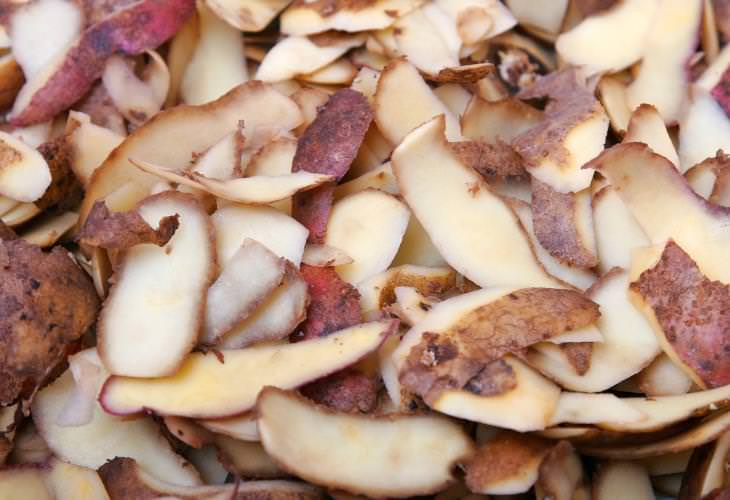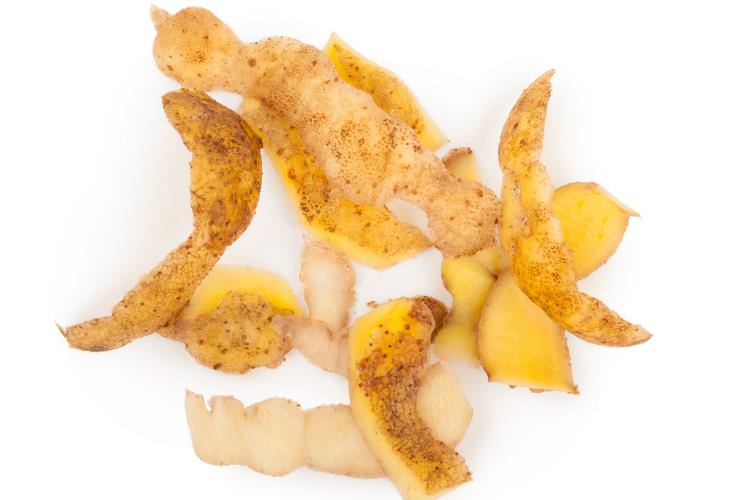One vegetable that’s available in almost
every household across the world is the humble potato. This vegetable is
adored all over the world for its versatility and taste. The number of
dishes that can be prepared with a potato is endless! However, while
preparing anything with potatoes, what is the first thing we do? We peel
them and toss the peels into the bin. What good are they, after all...
Right? But what if we told you that the skin is the most nutritious part
of a potato? Not only that. Potato peels can also be beneficial for
your skin and hair in a variety of ways!
Today, we will show you some surprising and
little-known benefits of potato skins. Considering that potato peels
are discarded as waste and not effectively utilized, you are likely to
be shocked by the information below.
1. They are quite nutritious!


For starters, the potato peel has a very
impressive nutritional profile. By adding it to your diet, you will get a
variety of vitamins and minerals. According to the USDA, 100 g of raw
potato peels contains 83.3 g of water and gives 243 kJ of energy. Apart
from that, the skins also include:
Protein: 2.57 g
Dietary fiber: 2.5 g
Calcium: 30 mg
Iron: 3.24 mg
Magnesium: 23 mg
Phosphorus: 38 mg
Potassium: 413 mg
S
odium: 10 mg
Zinc: 0.35 mg
Copper: 0.42 mg
Manganese: 0.6 mg
Selenium: 0.3 mcg
Vitamin C: 11.4 mg
Vitamin B3: 1.03 mg
Folate: 17 mcg.
2. Good for heart health
Since potato peels are rich in potassium, an essential mineral for
maintaining and regulating blood pressure, they are considered good for
heart health. They are also loaded with magnesium and calcium, which,
according to Harvard Medical School, also help control blood pressure.
Furthermore, studies indicate that these peels have powerful radical
scavenging, or antioxidant, activity because of chlorogenic and gallic
acids – two dominant compounds that help maintain the health of your
heart by reducing damage caused by free radicals. Recent research has
shown that free radical damage may cause many chronic health problems,
such as cardiovascular and inflammatory diseases. Antioxidants can
prevent that damage, as they eradicate free radicals by neutralizing
them.
3. They can help heal wounds
Potato peels contain terpenes and flavonoid
organic compounds, both of which have been proven to prevent bacterial
and fungal infections. Moreover, studies show the skins of this amazing
vegetable can also be used for healing wounds and preventing bacterial
growth. They do so by encouraging skin growth and supplying tensile
strength to the wounded skin.
In addition, potato peels can be used as an alternative for wound
dressing because they moisturize the skin, not to mention that they are
readily available, inexpensive, and easy to apply.
4. They act as a natural hair coloring agent
A little-known benefit of potato skins is that they can color grey hair.
The peels contain several vital nutrients, such as iron, zinc, copper,
calcium, potassium, niacin, and magnesium that help provide a natural
look and color to your hair. So, if you're looking for a natural and
eco-friendly way to dye your hair, just use potato peels.
5. Help lighten dark spots
Apart from antioxidant and antibacterial
compounds, potato skins also contain phenolic compounds. Together, these
compounds have a brightening effect on the skin. Meaning, they can help
lighten dark spots on the skin or help reduce dark circles that appear
under the eyes.
All you need to do is collect some fresh potato skins and rub them over
the dark spots for a few minutes. Alternatively, you can make a fine
paste of the peels and rub them on the problem area every day. You
should start seeing results in about three weeks!
6. Anti-inflammatory and anti-allergy effects


Potato skins are a natural source of a
flavonoid called quercetin. Flavonoids are a group of natural substances
found in fruits, vegetables, plants, and trees that are believed to
protect against disease. The flavonoid quercetin has been shown to have
an anti-inflammatory and antioxidant effect that protects the body
against disease and infection.
A 2016 study published in the journal Molecules showed that quercetin
can be effective for treating bronchial asthma, allergic rhinitis, and
peanut-induced anaphylactic reactions. The authors of the study also
stated that quercetin is the main ingredient in several potential
anti-allergy drugs.
7. Can reduce glucose levels
A study that analyzed the anti-diabetic effects of potato peels found
that the dietary fiber and polyphenols in potato peel powder can help
lower glucose levels when added to the diet for at least four weeks.
Furthermore, the vegetable’s skin also helps limit free radical damage
to the liver and kidneys and enhances their functions in people with
diabetes.
Ways to Use Potato Skins
Now that we have established that potato
peels are good for your health, how should we add them to our diet?
Well, there are numerous recipes out there for making dishes with potato
skins. But, you must first make sure that you are eating them in a
healthy way. Otherwise, you won’t get their nutritious benefits.
If you are looking for interesting ways to add potato skins to your
diet, here are a few unique suggestions you might like:
* Add them to your salads for a low-calorie healthy lunch.
* Bake a potato without peeling off its skin and add salt and pepper,
and very light simple toppings for a nutritious and delicious snack. For
this, first put the potatoes in a 400 °F (204.4 °C) oven for an hour
and let them bake until the flesh is very soft. Next, cut the potatoes
down the middle and insert your favorite toppings.
* Bake potato skins with sour cream, chives, and bacon for a yummy
snack.
* Rub the cleaned skins with olive oil and kosher salt and bake them
until crispy.
How to Choose Potato Peels?
While potato skins are safe to eat, just make sure to wash them well
before cooking to get rid of all the dirt. However, experts say that we
shouldn’t eat a potato peel that’s turned green. Since potatoes grow
underground, they start turning green when exposed to light. This green
color appears because of chlorophyll pigmentation. When this happens, it
leads to the formation of an alkaloid called solanine, which can be
toxic to humans when consumed in large amounts. Therefore, it’s better
to discard a potato that’s acquired a green tinge.